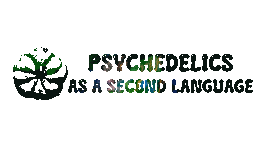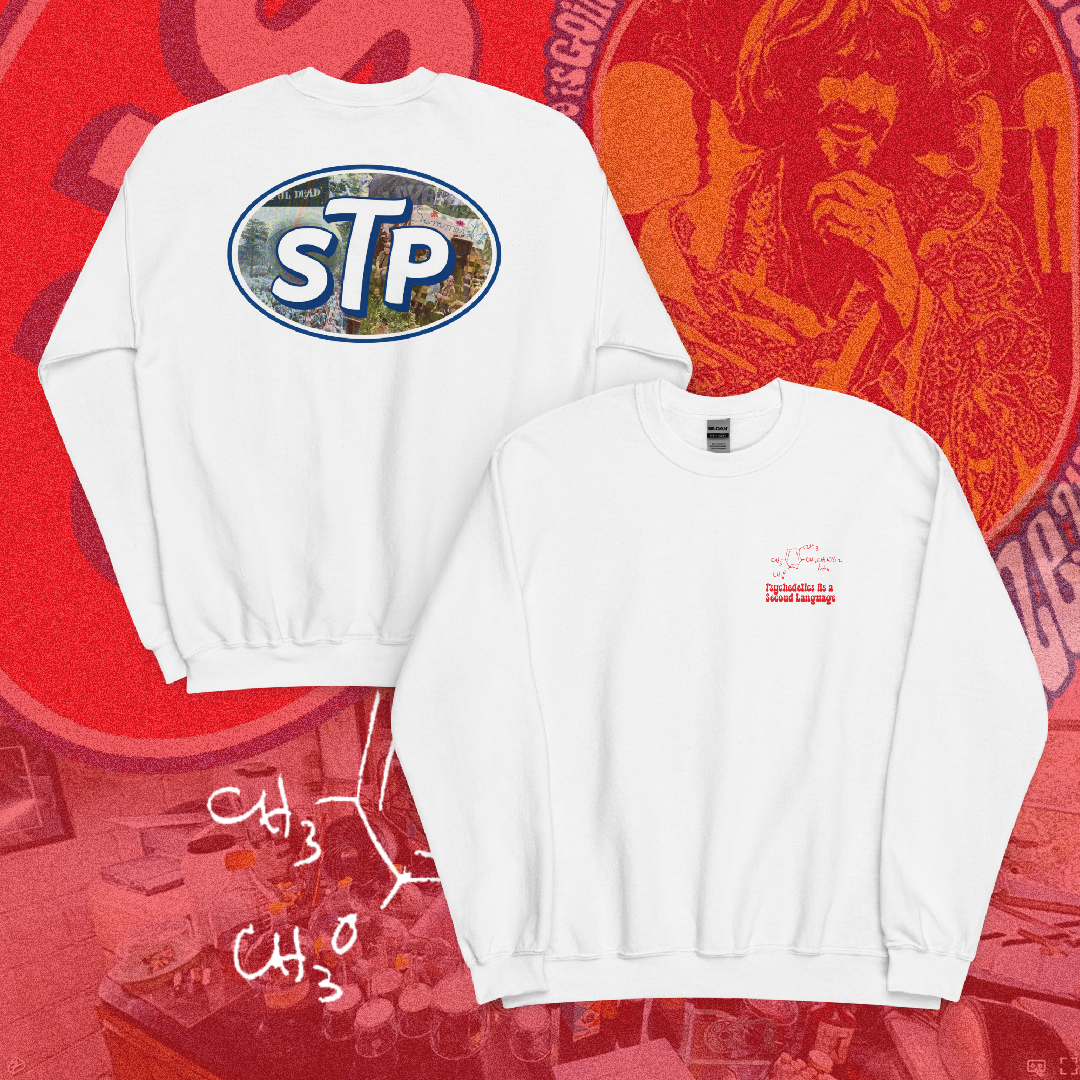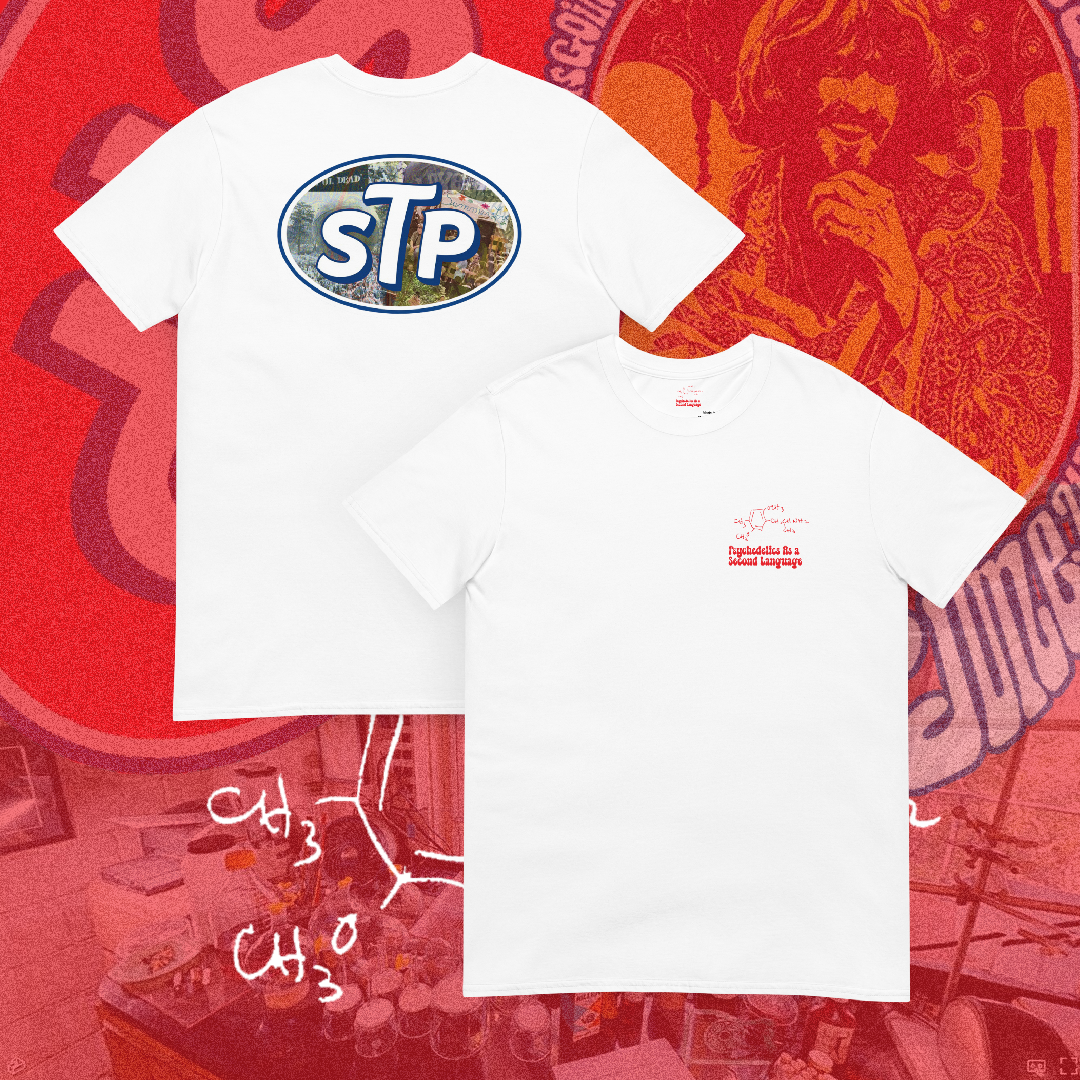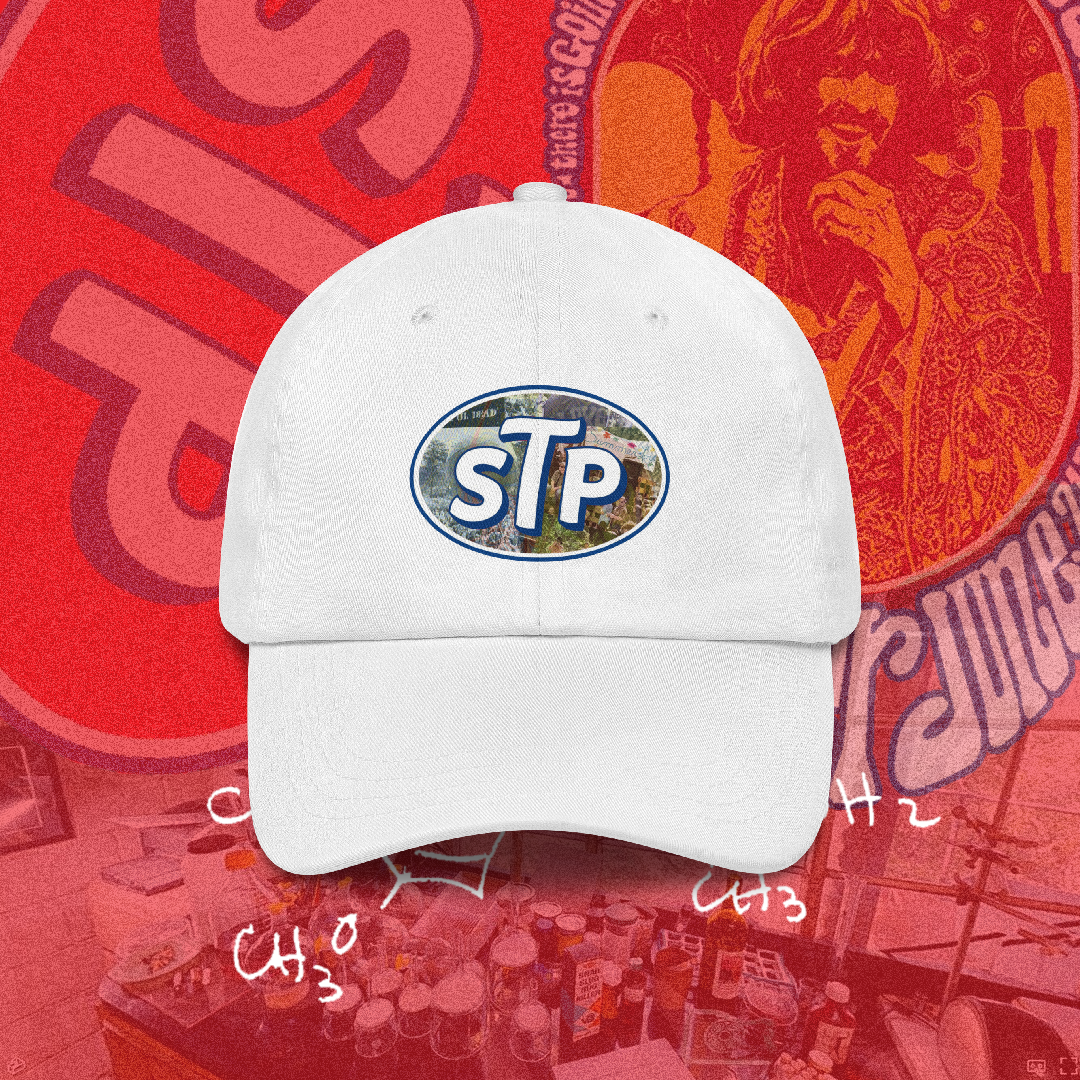Meet the origins of DOM (STP)
If you were born in the 1960s, you’ve likely heard about the compound DOM, but perhaps under a slightly different acronym, based on the oil and lubricant company STP and an abbreviation for Serenity, Tranquility, and Peace.
Despite its popularity during that decade, DOM holds one of the biggest mysteries among Shulgin’s creations.
To understand this mystery, we must first travel back to 1963, the year when the loved character by the psychedelic community, Alexander ‘Sasha’ Shulgin, created the molecule 1-(2,5-dimethoxy-4-methylphenyl)propan-2-amine, a psychedelic amphetamine later on known as DOM, an abbreviation for des-oxy-methyl, to pay respect to its relationship with 1-(2,4,5-trimethoxyphenyl)propan-2-amine (TMA-2) during his research for new psychiatric medicinals while at Dow Chemicals.
Remembering DOM (STP) and
the Summer of Love
During the same period, Shulgin invented another compound, 2,5-Dimethoxy-4-ethylamphetamine, commonly known as DOET (Those familiar with chemical nomenclature and chemistry will notice that these compounds have similar structure and pharmacological properties.) If we were to look closely at their structure, we would see a resemblance in a naturally occurring alkaloid (interestingly enough, this compound was Shulgin’s first experience with psychedelics), Mescaline, and the discovery of TMA (3,4,5-trimethoxyamphetamine), a compound with twice as potency as Mescaline and distinct pharmacology due to the amphetamine backbone present in TMA in comparison to the Phenethylamine backbone present in Mescaline, making TMA not only a partial agonist at the 5-HT2x receptors but also having a stronger adrenergic and dopaminergic activity contributing to its stimulating effects. (We will be covering more about TMA in the future. In the meantime, you can read more about TMA’s entry in PiHKAL here! )

Both DOM and DOET interested Shulgin immensely.
Even if the recorded dosage of DOM barely broke the threshold range during 1963 and 1964, Shulgin experimented with dosages ranging from 200 μg at first, reporting almost no effect, 2 months later, he ventured to try 1 mg separately taken (400 μg followed by another 400 μg one hour later and 200 μg added 2 hours and 10 minutes after the first dose), he followed it 5 days later with 1.6 mg, he described experiencing threshold effects in one of his lab notes.
The first actual documentation about DOM being hallucinogenic was by a friend and researcher collaborator, Thornton W. Sargent, on February 3, 1964, using 2.3mg—Sargent described mood elevation and enhancement of color perception.
Another co-worker under the name “W” reported the first data on the compound being considered a psychedelic after ingesting 4.1 mg on November 6, 1964— the reports of “W” were featured in Shulgin’s book PiHKAL on pages 53 – 56; He described the effects as fragile hallucinations with pulsating pastel colors appearing around 6 hours into the experience.
Using data collected from friends and colleagues, Shulgin authored a preliminary report on DOM for Dow to facilitate the submission of an Investigational New Drug (IND) application; Shulgin also urged Dow to patent both drugs—There were concerns within the patent department due to “prior art” published by Marsh and Herring in 1950, which described the pharmacology of 4-methyl substituted amphetamines— Despite these issues, Shulgin successfully obtained patents for both DOM and DOET in England in 1969 and the United States the following year.
Both compounds began to gain attention beyond Dow Chemicals. During a discussion between Shulgin and Solomon H. Snyder, a researcher at Johns Hopkins, the potential for future research involving these molecules caught the interest of Johns Hopkins. Their interest in exploring DOM and DOET in humans was mentioned until August 1966, when they submitted research protocols to Dow Chemicals, which only mentioned DOET.
Just like that, DOM became forgotten in the clinical realm.
Shulgin would mention DOM once again in a lecture at Johns Hopkins on January 25, 1967 (ladies and gents, buckle up and let me tell you that this date could be a key date to uncover the mystery behind DOM). During his lecture, Shulgin later suggested that this was the moment of initial public disclosure regarding the structure and synthesis of DOM. However, some believe that on this very day, he could have provided something more significant to someone who plays a crucial role in the story of the compound.

The mystery surrounding DOM lies in why, among the over 200 compounds synthesized by Shulgin, it was DOM that “escaped” the lab and became popularized and rebranded as STP. How did this compound become so readily available so quickly, and what was Shulgin’s role in this entire story?
Until the Johns Hopkins Talk and its contents were cleared with Dow’s legal department, only internal literature existed at Dow on DOM in January of 1967. There was no publishing of the compound, and even the pharmacology notes shared with Snyder did not mention its identity beyond the acronym DOM. That being said, no one outside of Dow knew anything about the identity of DOM until the Johns Hopkins talk in January 1967. Information about the compound was first shared in the inaugural issue of Microgram in November 1967, in which they claimed that they had acquired tablets of a new drug under the name STP in April 1967. Berkeley Barb also mentioned a new drug under the name STP, claiming that it lasted four times as long as acid and would soon be on the streets.
In general, compounds usually take longer than three months for clandestine operations to find the correct synthesis route and distribute it to the streets, thereby making an impact in the media. How could DOM make such a quick entry and impact, and what’s with the branding STP?
The answer to this question lies in two pivotal people in this story, the Grateful Dead audio engineer and clandestine chemist Owsley Stanley (future to be known as Acid King for his endeavor of producing at least five million doses of acid throughout his career as a clandestine chemist) and his colleague (who was also involved in building electronic equipment for the Grateful Dead and would also take part not only as an apprentice as an acid maker but also involved in the legendary Orange Sunshine acid) Tim Scully.
Although there is no exact date, Shulgin had provided DOM to Stanley. Based on Tim Scully’s biographical essays, we can determine the timeframe from the Johns Hopkins talk in January to early February. We must note that Shulgin solemnly gave the compound to Stanley. Shulgin did not provide him with instructions or advice on how to create the compounds. Scully performed the synthesis through his own research.
The missing piece of the puzzle about the synthesis route for the compound would delay Stanley’s ability to produce the molecule by a few months. It is supposed that Stanley might not have had DOM ready in time for the summer solstice celebration. Yet, STP made a memorable impression and a name at the San Francisco Summer Solstice music festival, held in Golden Gate Park on June 21, 1967, when Stanley gave away several thousand tablets at no cost to attendees.

But one thing still kept people up at night when it came to this mystery. Why would Shulgin give DOM to Stanley? He was aware of the potential repercussions of doing so, so why did he decide to take the risk?
To that, we still don’t have an evident answer, and probably only Shulgin himself could share his reasonings, so for now, all we can do is speculate. The most logical theory is the fact that Shulgin believed DOM had tremendous therapeutic and scientific value, but with the path Dow Chemicals was taking, the molecule would become forgotten and unused. Shulgin understood that although the compound was still legal, once he left Dow, he would lose legal access to DOM and would be unable to study or publish his findings without risking legal consequences.
At that time, Shulgin regarded DOM as his most promising compound, with early indications suggesting it could have potential benefits for both medical and psychiatric conditions. He began to worry that DOM might fall into “pharmacological oblivion.” The talk at Johns Hopkins may have inspired a way to safely disclose the synthesis of the molecule. Without this lecture, it is uncertain whether Shulgin would have discovered a way to share the synthetic route of DOM with Stanley. It raises a reasonable question: Would Shulgin have chosen to share the molecule without the potential cover story provided by the talk? Tim Sculley’s archives reveal that Shulgin suggested to Stanley that he use this talk as the cover story for how he learned about DOM.
Get access to exclusive previews and be in touch with our community by joining our Discord!
Stanley wasn’t the only person seeking Shulgin’s guidance to replace LSD with DOM after the compound became illegal. Nicholas (Nick) Sand (linked to the future Orange Sunshine) also attempted to contact Shulgin for a sample of DOM around December 1, 1966. However, among everyone interested in the compound, who distributed DOM during the Summer Solstice music festival?
According to Scully’s archives, by the time Stanley distributed the free Serenity, Tranquility, and Peace (the actual acronym for STP) during the Summer Solstice music festival, Scully was still perfecting the final crystallization of its hydrochloride salt, meaning that the DOM produced in Denver wasn’t ready for distribution to the public by Stanley, and that the material tableted and given away at the Summer Solstice Celebration in Golden Gate Park, was in fact, the samples given to Stanley by Shulgin himself. But the situation would soon change when Scully’s STP became available, followed shortly by Sand’s STP production in 1967.
And just like that, and like every psychedelic we currently have on the dense scheduling list, popularization of a compound that could have a clinical value, DOM climbed through the demonization of the media to governmental entities that would make this compound illegal, inevitably ending up as Shulgin feared, another compound lost in “pharmacological oblivion.” Yet, DOM’s emphasis on what we now understand about serotonin receptors in the action of hallucinogens and the identification of the 5-HT2A as a critical biological target shouldn’t be forgotten as the compound remains a valuable tool in the search for new psychedelics and in evaluating the receptor specificities of other compounds in the therapeutic potential of psychedelics making it clear that legalization of compounds must be done for scientific evolution in the current tools to understand the human mind.










